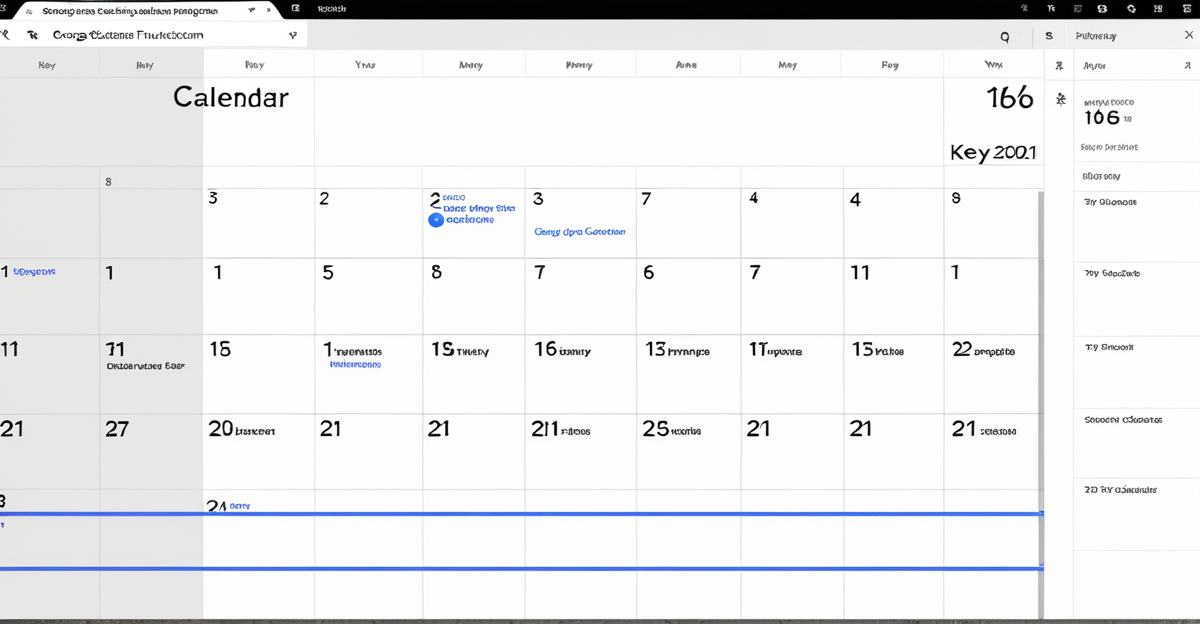Master Google Calendar’s features to organize your time efficiently and boost productivity. From creating detailed events and setting smart reminders to sharing calendars and syncing across devices, these tools help you stay on track effortlessly. Whether managing work meetings or personal goals, understanding these key functions can transform how you schedule and prioritize daily tasks.
Core Features and Essential Tools in Google Calendar
Efficient event scheduling is at the heart of Google Calendar. You can quickly create, edit, and delete events with start and end times or mark activities as all-day. This page explains it in detail: Discover the link here. To streamline organization, events can be easily color-coded—assigning different shades for meetings, personal appointments, or recurring commitments.
In the same genre : What role does cybersecurity education play in UK schools?
Google Calendar’s view options allow you to toggle between daily, weekly, monthly, and agenda (schedule) formats, ensuring everyone can visualize their timetable with clarity. Switching views is seamless across devices, thanks to robust syncing that keeps your updates instant and consistent.
Setting up reminders and notifications is straightforward. Whether by push notification, email, or both, you’ll receive timely prompts for events and tasks, reducing the risk of missed appointments. For repeated obligations, the recurring events setup simplifies scheduling by letting you define custom repeat patterns—ideal for weekly team meetings or monthly billing reminders.
Also to read : Top google calendar features for boosting your productivity
Calendar sharing empowers collaboration. You can invite participants, manage RSVPs, and tailor privacy settings, deciding who sees what. Integrating with other Google services such as Gmail enhances the experience, automatically pulling relevant events or locations into your agenda for effortless planning.
Advanced Functionalities and Integrations
Seamless integration with Gmail, Google Meet, and video conferencing
Google Meet integration is central to organizing modern meetings. When creating an event, adding a Google Meet link is now almost instant. This approach streamlines video conferencing features for work, school, and remote gatherings. The calendar makes joining, scheduling, and sharing Google Meet sessions straightforward, with event invites and notifications handled automatically. Across devices, syncing across devices guarantees you never miss a video call, whether on desktop or through the mobile app features.
Attaching files, locations, and links to events
Efficient event location integration transforms your schedule into a practical hub. By attaching addresses, Google Maps links, and event attachment uploads—like PDFs or collaborative docs—each appointment becomes more actionable. Event attachment uploads allow context: meeting notes, slides, or documents can be attached so every attendee arrives prepared. Calendar entries also support location integration, which provides smart navigation to in-person events.
Smart suggestions and automatic event creation from Gmail
Leveraging smart suggestions for events saves time and reduces errors. The system scans Gmail for reservation confirmations or scheduled plans, auto-generating events. Smart suggestions for events recommend event titles, locations, and participants, accelerating the event creation process. For increased productivity, Google Tasks integration enables you to add to-do items and track progress directly within your calendar, synchronized across all devices.
Managing Multiple Calendars and Customization Options
Using and customizing multiple calendars and templates
Multiple calendar management in Google Calendar streamlines organizing work, personal, and project schedules within one account. You can easily create both public and private calendars for different life areas or teams, and switch visibility as needed. Applying calendar customization features, such as color labels for calendars and personalized calendar templates, offers a quick overview and speeds up event creation. For recurring activities, templates save time and keep details consistent.
Setting calendar and event privacy, permissions, and user roles
Customizing shared calendar permissions grants others either viewing or editing rights. Use event privacy controls to decide who can see details: set events or entire calendars as private, public, or visible only to specific users. Assigning user roles—like managing editors or viewers—prevents unauthorized changes. These privacy features allow fine-tuned collaboration while maintaining required confidentiality in a collaborative setting.
Color-coding events and calendars for better organization
Applying color labels for calendars and diverse event color themes lets you distinguish between types of activities or team projects instantly. Paired with calendar templates, these visual cues reduce confusion when reviewing busy schedules. The result is a visually organized interface where events from various public and private calendars remain clear and accessible at a glance.
Most Recent Updates, Limitations, and Expert Tips
Noteworthy recent updates and user feedback (2021–2024)
In the past three years, Google Workspace calendar features have expanded, focusing on calendar accessibility options and real-world collaboration needs. Updates have strengthened focus time scheduling, enabling users to reserve distraction-free blocks. The evolution of mobile app features—like widgets, rich notifications, and user-friendly layouts—improves quick access and flexibility. For families, family calendar features enable event sharing and group plans across Google accounts. User feedback prompted tweaks, especially to recurring events and event conflict alerts, enhancing awareness of overlapping commitments.
Known limitations and synchronization issues
Despite robust capabilities, users often face calendar sync frequency problems across devices. Real-time updates may lag, particularly with shared or imported calendars using advanced scheduling features or when integrating with external platforms. Limitations also appear in calendar accessibility options, leading to occasional frustration for visually-impaired users. Some issues persist around managing permissions in family calendar features and with the reliability of event conflict alerts when schedules grow complex.
Useful tips for productivity and troubleshooting common issues
Maximize productivity by leveraging Google Workspace calendar features like focus time and dynamic event suggestions. Adjust calendar sync frequency settings if changes seem delayed. For smoother cross-device usage, check connectivity and app versions. Take advantage of calendar troubleshooting tips found in Google’s help resources to resolve persistent sync or conflict alert issues efficiently.





